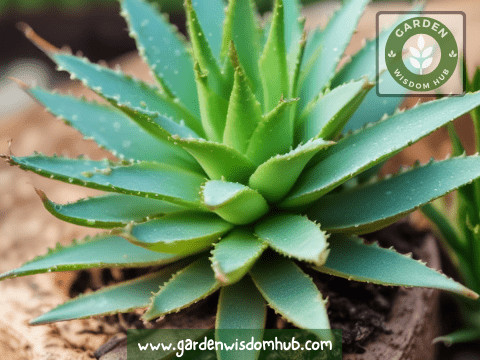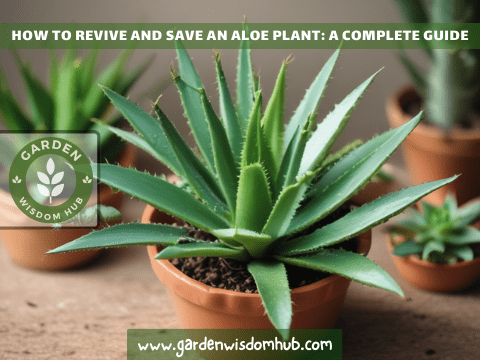How to save an Aloe plant?
Are you worried about your aloe plant? No matter the cause—overwatering, root rot, or frost damage—you can resuscitate your beloved plant. This aloe Vera is great! It is easy to care for and has amazing therapeutic benefits. With a little care, it can thrive and surprise you with its resilience. I have a great approach to reviving and growing your aloe plant.
How do I know if my aloe vera plant is dying?
Is your aloe Vera plant looking poorly? Find out what’s wrong and how to revive the aloe plant. How can you determine whether your aloe Vera plant requires special care? Let’s examine the indicators of plant issues.
The Aloe vera plant turning brown and soft is the first sign. Watch for leaves turning yellow, mushy, or browning and softening. These indications may indicate overwatering, root rot, or cold damage.
How to revive aloe vera without roots?
Can you revive an aloe vera plant without roots? Don’t worry if your aloe has no roots. Try propagating new plants from cuttings or offshoots to save it! Transfer healthy plant pieces to well-draining soil carefully. These plants can thrive with proper care.
Aloe leaves turning brown, how to save them?
Aloe vera plants can turn dark and limp due to overwatering or sunshine. If you want to save your plant, figure out what’s wrong and change your care regimen. Finding balance is key! First, dry the soil before watering overwatered plants again. Give them a chance to heal and thrive! Move burnt plants to a shaded spot and avoid direct sunshine.
How to save an aloe plant with no roots?
How can I revive a rootless aloe plant? You can save an aloe plant without roots! You can grow plants from cuttings or offshoots. Remove the healthy parts of the plant and then follow the methods to propagate aloe vera in soil or water. We’ll grow fresh aloe vera plants with this fascinating procedure!
How to save an aloe plant without roots indoors:
Follow the same techniques for propagating aloe vera in soil or water to save an indoor plant without roots. Find a warm, sunny area for cuttings or offshoots. Don’t overwater them while they root.
Caring for an Aloe Vera:

Aloe plants need proper maintenance to be healthy. Water your plant carefully, give it bright, indirect sunshine, and use well-draining soil. You should repot your plant every few years to give it room to expand.
Overwatered aloe plants: how to tell?
Do you wonder what an overwatered aloe plant looks like? Overwatering can cause root rot in aloe plants. It’s common, but you can avoid it! Talk positively and engagingly! Root rot-stricken aloe plants can be saved! To save a root-rotted plant, remove the roots and put it in nutrient-rich, well-draining soil. It’s easy and efficient for reviving your plant! Do not overwater and ensure the plant has good drainage.
How to save an aloe plant from cold damage?
How to resuscitate a cold-damaged aloe plant? Let’s discuss useful tips! Move your cold-damaged aloe plant to a warm, well-lit spot. We recommend not watering it for a week. Remove damaged plant parts and transplant them into fresh soil. With proper care, your plant will recover.
How to save an Aloe plant indoors?
Look no further! These instructions will help you keep your Aloe plant healthy and happy at home. Aloe vera plants can recover from many problems if given sufficient care. Incredible how well they flourish indoors! Early detection and treatment can save your aloe plant and let you enjoy its beauty and benefits for years!
Frozen Aloe Vera plant indoors.
Your aloe plant may have been damaged by frigid weather. Bring your frozen aloe plant indoors to a warm area to revive it. Sunlight can stress the plant, so avoid it. Review the problem and determine what needs to be done. Discolored or soft leaves may need to be removed. Trim damaged plant tissue to healthy tissue. To avoid injury, use high-quality scissors or pruning shears. Give the plant time to recuperate after eliminating harm. We recommend waiting a week before watering. This will allow the plant to recover without root rot. After this period, you can water again but don’t overdo it. Watch for signs of recovery in your plant. Seeing fresh growth on your plant indicates recovery. Maintaining proper maintenance, such as sunlight and well-draining soil, will help it recover.
How to save an aloe plant that froze?
Saving the frozen aloe plant requires a warm indoor environment. Sunlight can stress the plant, so avoid it. Let the plant rest for a week without watering. This will help the plant recover and prevent root rot.
Aloe plant froze outside:
A frozen aloe vera plant must be kept inside. It needs a warm, sunny atmosphere to thrive indoors. Avoid overwatering the plant. Place the plant in soft sunshine away from drafts and heaters.
How to save an aloe plant with root rot?
Let the plant rest for a week without watering. This will aid recovery and prevent root rot. After this period, you can water normally but don’t overwater. Watch for signs of new growth on the plant. Give it lots of sunlight and make sure the soil drains effectively to help it recover. Your aloe vera plant will recover from freezing and thrive indoors with patience.
- Watch this YouTube Video For More Guide Related to The process of saving a dying Aloe vera plant
How to revive an aloe plant easily?

Reviving an aloe plant is easy with the appropriate strategy. If your plant is struggling, let’s assess its environment and care. Make sure it gets enough sunlight, but avoid direct sunlight to avoid sunburn. Checking soil moisture next. Aloe Vera plants should dry out between waterings to avoid overwatering. We recommend drying off the top inch of soil before watering again. If your plant has stressed leaves that are yellow or brown, carefully remove them. Shifting plant energy to healthier places can be advantageous. Follow these simple procedures to revive and grow your aloe plant.
Why is my aloe plant turning brown?
Aloe plants can become brown from overwatering, sunshine, or freezing temperatures. Check your aloe plant’s care routine when it becomes brown. Avoid direct sunlight and let the soil dry before watering again. You can easily cut brown leaves. Making the plant look better and focusing its energies on healthier growth can make a big difference. Bright side, extensive browning or affecting young growth may indicate root rot. Repotting the plant in new, well-draining soil may help. Trimming damaged roots may also help.
You may also like: Exploring 10 Varieties of Fast-Growing Indoor Plants
FAQs About Save Your Aloe Plant:
My Aloe Plant froze, what to do?
Saving the frozen aloe plant requires a warm indoor environment. Sunlight can stress the plant, so avoid it. Let the plant rest for a week without watering. This will help the plant recover and prevent root rot.
After this period, you can water normally, but don’t overwater. Watch for new growth in the plant. Continue to give your plant enough sunlight and well-draining soil to help it recover.
How to save an aloe plant with root rot?
To save a root-rotted plant, remove the roots and put it in nutrient-rich, well-draining soil. It’s easy and efficient for reviving your plant! Do not overwater and ensure the plant has good drainage.
How to save an aloe vera plant without roots?
Your aloe plant can survive without roots! Create new plants from cuttings or offshoots to save them. Take out the healthy parts and follow the soil or water propagation recommendations for aloe vera.
Why is my aloe plant turning brown?
Aloe plants can become brown from overwatering, sunshine, or freezing temperatures. Check your aloe plant’s care routine when it becomes brown. Avoid direct sunlight and let the soil dry before watering again.
What should I do with brown leaves?
You can easily cut brown leaves. Making the plant look better and focusing its energies on healthier growth can make a big difference. Bright side, extensive browning or affecting young growth may indicate root rot. Repotting the plant in new, well-draining soil may help. Trimming damaged roots may also help.
To learn more about Houseplants check out my guides:
Spider Plant Growth Stages Life Cycle & Care Guide
Spider Plant Care Propagation Tips & Tricks for a Bushier Plant
6 Types of Spider Plants Exploring the most common top varieties
Tips to Save a Dying Corn Plant: A Step-by-Step Complete Guide
How to Care for Majesty Palm: Essential Tips for Healthy Growth
Aloe Plant Overwatered: Signs and Step-by-Step Solutions
6+ Signs of an Underwatered Aloe Vera Plant (And to Revive It)
Plants That Look Like Aloe Vera
Ultimate Guide To Growing Herbs Indoors With Grow Light In Pots
A Complete Guide On Starting Your Very Own Indoor Herb Garden
The Ultimate Guide to Bird of Paradise Care and Growing
Different Varieties of Tall Succulents and Cacti
James Porter
Welcome to our haven of gardening and plant care, where outdoor and indoor planting enthusiasts come together! At Gardening Wisdom Hub, we aim to provide you with the most authentic information on anything related to gardening, plant care, seasonal planting etc.
The author of our website is James Porter, an experienced industry veteran. He has a deep interest in everything green. James’s enthusiasm for exploring plants’ features and learning new gardening methods began at a young age. Gradually, his passion increased with time, leading him to become a highly esteemed professional. His extensive knowledge makes him a priceless resource for inexperienced and seasoned gardeners.

